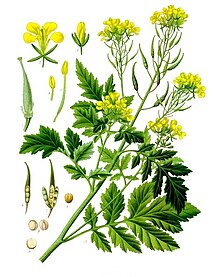White mustard
Species of flowering plant From Wikipedia, the free encyclopedia
Species of flowering plant From Wikipedia, the free encyclopedia
White mustard (Sinapis alba) is an annual plant of the family Brassicaceae. It is sometimes also referred to as Brassica alba or B. hirta. Grown for its seeds, it is used to make the condiment mustard, as a fodder crop, or as a green manure. It is now widespread worldwide, although it probably originated in the Mediterranean region.
| White mustard | |
|---|---|
 | |
| Scientific classification | |
| Kingdom: | Plantae |
| Clade: | Tracheophytes |
| Clade: | Angiosperms |
| Clade: | Eudicots |
| Clade: | Rosids |
| Order: | Brassicales |
| Family: | Brassicaceae |
| Genus: | Sinapis |
| Species: | S. alba |
| Binomial name | |
| Sinapis alba | |
| Synonyms | |
| |

White mustard is an annual, growing to 70 centimetres (28 in) high with stalkless pinnate leaves, similar to Sinapis arvensis.[1]
Most common in Europe, North Africa, the Middle East and Central Asia, it can be found worldwide. It has been found as far north as Greenland,[2] and naturalized throughout Great Britain and Ireland.[3]
The yellow flowers of the plant produce glabrous or sparsely bristled seed pods. Each fruit (silique) contains roughly a half dozen seeds. The plants are harvested for their seeds just prior to the seed pods becoming ripe and bursting open (dehiscing).
White mustard seeds are hard spheroid seeds, usually around 1.0 to 1.5 mm (0.039 to 0.059 in) in diameter,[4] with a color ranging from beige or yellow to light brown. They can be used whole for pickling or toasted for use in dishes. When ground and mixed with other ingredients, a paste or more standard condiment can be produced. Sinapis alba is used to make the commonplace yellow table mustard, with additional yellow coloring provided by turmeric in some formulations.
The seeds contain sinalbin, which is a thioglycoside responsible for their pungent taste. In Sinapis alba, the glucosinolate sinalbin is broken down by enzymes like myrosinase, resulting in the formation of 'white principles.' These white principles consist of p-hydroxy benzyl isothiocyanate and p-hydroxy benzylamine.[5] White mustard has fewer volatile oils than black mustard seeds, and the flavor is considered to be milder.[6][7]
In Greece, the plant's leaves are eaten during the winter, before it blooms. Greeks call it vrouves (βρούβα) or lapsana (λαψάνα). The blooming season of this plant (February–March) is celebrated with the Mustard Festival, a series of festivities in the wine country of California (Napa and Sonoma Counties).[citation needed]
White mustard is commonly used as a cover and green manure crop in Europe (between the UK and Ukraine). A large number of varieties exist,[8][9] mainly differing in lateness of flowering and resistance against white beet-cyst nematode (Heterodera schachtii). Farmers generally prefer late-flowering varieties that do not produce seeds which may develop into weeds in the subsequent year's crop rotation. Early vigor is important to cover the soil quickly to suppress weeds and protect the soil against erosion. In rotations with sugar beets, suppression of the white beet-cyst nematode is an important trait. Resistant white mustard varieties reduce nematode populations by 70-90%.[citation needed]
Seamless Wikipedia browsing. On steroids.
Every time you click a link to Wikipedia, Wiktionary or Wikiquote in your browser's search results, it will show the modern Wikiwand interface.
Wikiwand extension is a five stars, simple, with minimum permission required to keep your browsing private, safe and transparent.